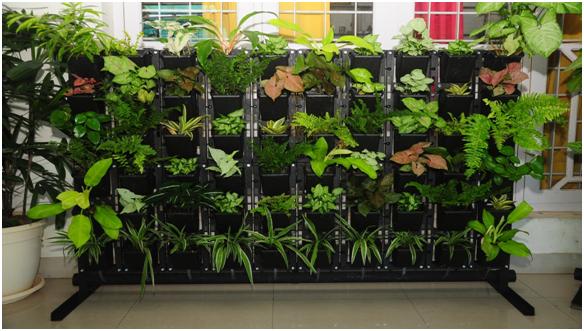
When grown on trellises, vegetables like beans, cucumbers, squash, and grapes grow healthier than ground-grown crops. They have more room to spread out and the extra airflow prevents overcrowding and disease.
Various trellises can be built from repurposed materials including old fences, twine, cans, buckets, PVC pipe, and even old ladders. Premade trellis systems are available as well.
Design
When it comes to creating a beautiful, productive garden, vertical gardening offers some unique benefits. It is much easier to harvest and less stressful on your back and knees because you don’t have to crouch or hunch over the plants like you do with traditional rows. It also makes the garden more visually appealing, which means you’ll be more likely to enjoy spending time there.
You can create a simple vertical garden out of materials you already have around your yard or home, such as twine, an old fence, repurposed containers, ropes, cans, ladders, PVC pipes, or even branches. You can also buy premade options such as plant cages, stackable planters, shelving, hanging wall planting pockets, and arches. More detail you can get here: shiv shankar landscape
For a more permanent solution, you can build an arched trellis out of wood or even recycled plastic, but be sure to check that the material is safe for reuse by looking for a stamp that displays the IPPC logo and letters EPAL, plus HT or DB. You’ll also want to sand any rough spots, patches, and sharp corners before using it as your vertical garden structure.
Trellises are especially important for vegetables and fruit that grow on vines, such as strawberries, muskmelon, beans, peas, cucumbers, squash, most melons, and vining tomatoes. In addition to providing more space, a trellis can keep those crops from overtaking the garden and crowding out your other plants.
Installation
Vertical gardening is ideal for growing vegetables and fruits that grow on vines, including strawberries, muskmelon, beans, peas, cucumbers, melons, pumpkins, most squash, and vining tomatoes. Using a trellis also makes it easier to tend your garden, as you won’t have to hunch over or kneel so much, and it’s friendlier on your back and joints.
There are a variety of ways to create a vertical vegetable garden, but you’ll want to make sure that your structure is sturdy and able to support your plants. You can use repurposed materials, such as old fences, twine, cans and buckets, PVC pipes, branches, and more. You can also purchase premade options, such as plant cages, stackable planters, shelving, and wall planting pockets.
If you’re thinking about trying out a vertical garden, start small and use materials you already have available to you. For instance, try a simple bean teepee that you can easily set up in a backyard or on a deck. This is a great way to try out vertical gardening, without spending a lot of money on something elaborate that may not work. It’s also a great way to get kids involved in the garden, helping them grow their own healthy snacks and bringing a sense of fun to the space. You can even make a beautiful arched trellis to create a walkway lined with fresh herbs and vegetables.
Maintenance
While most maintenance procedures are standard for any landscape work, vertical gardens require some unique attention. Due to their height, crews must be able to access all parts of the garden for maintenance purposes. This often requires additional equipment beyond the usual cherry picker. If gardens are too high to use a cherry picker, a suspension system similar to those used for rock climbing may be needed getting more details visit here shiv shankar landscape.
Vegetables planted in vertical gardens require regular weeding and monitoring to prevent overcrowding and disease. If vines are involved, they must be pruned to maintain the intended aesthetics and prevent them from becoming a fire hazard or to keep them from getting out of control.
Other maintenance tasks that must be performed on a vertical garden include irrigation checks, nutrients, and water levels. Additionally, if other renovations are planned for the building and will interfere with the vertical garden, the maintenance team must be notified so that they can schedule the necessary repairs around the gardening times.





